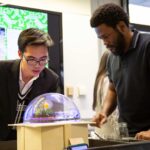
Formulating the future of materials research
Navrotsky establishes new award to encourage promising junior faculty in materials science

The inaugural Navrotsky Materials Early Career Encouragement Award for Materials Research was recently announced and awarded to Qijun Hong, assistant professor of materials science and engineering in the School for Engineering of Matter, Transport and Energy, part of the Ira A. Fulton Schools of Engineering.
Hong’s research incorporates quantum mechanical calculations and machine learning to uncover the mysteries of materials science.
This new award, funded by an endowment that supports the chosen faculty member for two years, rewards and encourages early-career faculty who have already received major federal grant awards, giving them the flexibility to pursue new and different ideas once their major work is funded.
The namesake and benefactor of the award, Alexandra Navrotsky, is a Regents Professor in the School for Engineering of Matter, Transport and Energy and the School of Molecular Sciences, or SMS. She is also an affiliated faculty member of the School of Earth and Space Exploration and the director of the Navrotsky Eyring Center for Materials of the Universe.
Recipients of the Navrotsky Materials Early Career Encouragement Award for Materials Research must be junior faculty, no more than 10 years past receiving their doctoral degree and less than four years as ASU faculty, who have tenure or tenure-track positions in physics or the aforementioned schools in which Navrotsky has affiliations. Approved research interests include the study of crystalline, amorphous and molten materials of fundamental, chemical, physical technological or planetary interest.
Navrotsky has had a significant influence on the earth sciences, promoting interdisciplinary collaboration across the fields of geochemistry, mineralogy, materials sciences and chemistry. Her discoveries have been fundamental in understanding the thermodynamic behaviors of minerals and other complex materials.
A major symposium to honor her lifetime achievements, the Navrotsky International Symposium on Geochemistry, will be held in Panama later this year.
As a senior researcher, Navrotsky seeks to create a lasting legacy by investing in the long-term success of multiple units in collaboration with the Navrotsky Eyring Center for Materials of the Universe.
Using machine learning to optimize materials research
Hong’s research draws on density functional theory, a computational quantum mechanical modeling method used to investigate the electronic structure of many-body systems and predict the properties of materials.
Quantum mechanical calculations are performed virtually through a series of algorithms and can be as accurate as physical experiments. These calculations can eliminate costly and cumbersome factors to save researchers time, money and energy.
Hong previously developed SLUSCHI, a script that automates the quantum mechanical calculation to determine the melting temperature of a given material.
Notably, Hong utilized quantum mechanics to discover the material with the highest known melting point during his doctoral studies.
One limitation of quantum mechanics is its lengthy processing time and high computational demand. Machine learning is an ideal supplement to counteract some of these shortcomings.
“The benefit of machine learning is it’s superfast, and if we have good data, it can be as reliable as quantum mechanics,” says Hong. “And when we combine these two approaches, they can be very powerful.”
With enough data, a machine learning model can develop algorithms and statistical models to analyze patterns and draw inferences.
“If we use quantum mechanics to generate the data for machine learning,” says Hong. “Once we generate enough data, the predictions generated are accurate. Then we can just build on the machine learning model and take advantage of the increased speed of this process.”
Hong’s group is undertaking a machine learning model initiative called the Materials Properties Prediction, or MAPP, project. The initiative will essentially function as a dictionary of materials properties, allowing the user to input the chemical composition of their target material and receive a list of the properties of the material.
Hong will use the funding granted from this award to expand the computing potential of his lab and increase the bandwidth of the MAPP project.
“MAPP currently covers five materials properties, but we’d like to expand it to dozens, even hundreds so then in the end, it will truly function as a dictionary of materials,” says Hong. “We will need more servers, more computers. We also need more people. I can use the funding to cover partly, my students, my scientists, so that’s great.”
When asked what may have motivated his receipt of the first Navrotsky Materials Early Career Encouragement Award for Materials Research, Hong provides two reasons.
“One is, of course, that the research I’m doing is exciting,” says Hong. “Secondly, I think my research fits very well with Professor Alex Navrotsky’s research. We’ve been collaborating since I was a grad student.”
“Qijun is a great scientist who is exceptional at what he does,” says Navrotsky. “Due to a set of fortunate happenstances, we’ve had the opportunity to work together for the past decade.”
Hong expresses his gratitude for being chosen, citing Navrotsky’s tenure as a major reason he chose to join ASU.
“I’m honored to be selected. I think it’s especially meaningful to me because it’s the Navrotsky Award,” says Hong. “She is my role model and a guiding light in my life. I believe that the collaboration, the exciting research between me and her group, will continue for many years to come.”



































